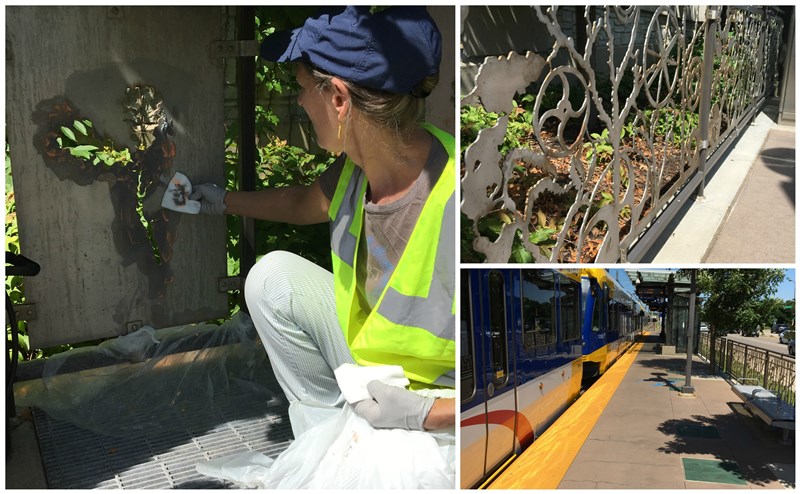
Because it’s so dispersed – and in some cases cleverly disguised – it’s difficult to appreciate how pervasive public art is across the transit system.
But with more than 70 distinct pieces, Metro Transit is the caretaker of one of the largest collections of public art in the state.
Stations along the Green and Blue lines each have unique art that reflects their surroundings. Artwork can also be found on the Northstar Commuter Rail Line as well as several bus stops, like the flowerpot shelter in North Minneapolis.
“The program aims to inspire discovery in otherwise predictable spaces, improving the rider experience and making it more pleasant,” Public Art Administrator Mark Granlund said.
Like any other part of the transit system, art needs to be maintained as time, weather and humans take their collective toll.
Granlund joined Metro Transit last year to take stock of the needs, begin a campaign to make necessary repairs and plan for future maintenance. Before coming to Metro Transit, he performed similar work for the City of St. Paul’s Parks & Recreation Department.
Restoration is getting underway in earnest this year.
Among the first signs was the recent appearance of professional conservators at the Blue Line’s 50th Street/Minnehaha Park Station, where oak leaves, vines and animals are reflected in metal fencing, bronze carvings and screened glass. Conservators began by cleaning the metal and removing graffiti.
“There is glass, bronze, and metal, and they all need reactive and proactive maintenance,” Granlund said.
Later this summer, 52 painted steel pieces that adorn a decorative steel fence at the Blue Line’s Cedar-Riverside Station will be disassembled, cleaned, repainted, and put back together. There are also plans to fix the small boxes that feature on-demand audio and video recordings, found at several Blue Line stations.
Facilities staff regularly clean stations and remove graffiti. But conservators have been brought in because they have expertise working with particular materials. The goal is to bring the art back as close to its original condition as possible while preserving the artist’s intent.
Because it’s just a few years old, artwork at Green Line stations is in relatively good shape and not yet in need of significant restoration. After learning lessons on the Blue Line, Green Line artwork was also designed to be more durable.
Getting the collection back in shape will be an exhaustive process, but Granlund said it’s well worth the time and energy.
“It’s definitely a major project, but in the end, taking care of the art is what we are entrusted with,” he said.
> Blue Line Public Art
> Green Line Public Art
> Transit Usage Guidelines (including public art proposals)